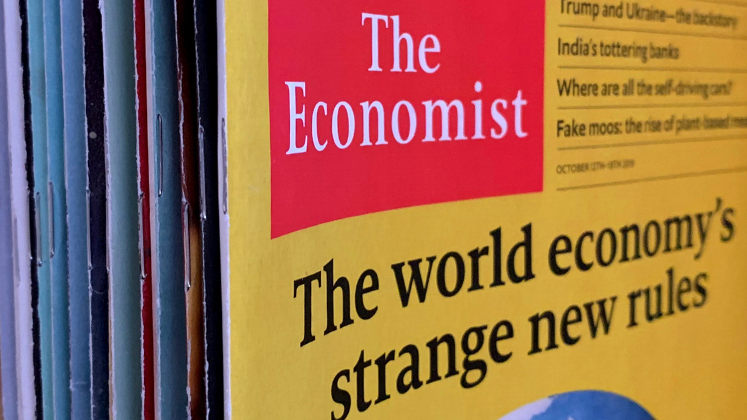In Liberalism at Large: The World According to the Economist, Alexander Zevin traces the 177-year history of the Economist newspaper, positioning the Economist not only as a lens for understanding reinterpretations of liberalism across different eras, but also as an active participant in influencing policy and public debate. This is a rigorous and meticulously researched study of the Economist’s history and the contingencies that shaped liberalism over the long term, writes Jenny McArthur.
Liberalism at Large: The World According to the Economist. Alexander Zevin. Verso. 2019.
 The theories and ideologies that form our political identities must be continuously reinterpreted in order to stay intact. This work of maintaining ideologies is given more attention than usual in Alexander Zevin’s Liberalism at Large: The World According to the Economist, which examines the history of liberalism through the 177-year history of the Economist newspaper. After rising to prominence with the Anti-Corn Law League in 1843, the Economist established itself as a weekly news outlet covering politics and business, combining intellectual thought-leadership with market reporting and statistics. This book shows how the newspaper balanced the self-appointed mandate of upholding liberalism against the practical demands of weekly print journalism, competitive media markets and different editors’ inclinations.
The theories and ideologies that form our political identities must be continuously reinterpreted in order to stay intact. This work of maintaining ideologies is given more attention than usual in Alexander Zevin’s Liberalism at Large: The World According to the Economist, which examines the history of liberalism through the 177-year history of the Economist newspaper. After rising to prominence with the Anti-Corn Law League in 1843, the Economist established itself as a weekly news outlet covering politics and business, combining intellectual thought-leadership with market reporting and statistics. This book shows how the newspaper balanced the self-appointed mandate of upholding liberalism against the practical demands of weekly print journalism, competitive media markets and different editors’ inclinations.
Liberalism binds together specific economic and political ideals, including free trade, low taxes and private property, accompanied by the rule of law, civil equality, free press and responsible government. Liberalism gained political traction in nineteenth-century Britain with the dispute over the Corn Laws: trade barriers that protected the interests of feudal landowners at the expense of manufacturers. Indeed, the Economist first emerged as a pamphlet for the Anti-Corn Law League, the movement that successfully campaigned for the Corn Laws’ abolition in 1846. Since then, liberalism has faced challenges to adapt to wider political and economic shifts: namely, democratic expansion, the rise and fall of empire and the growing power of global finance.
Liberalism at Large scrutinises the Economist’s reinterpretation of liberalism across successive wars, financial crises, geopolitical shifts and globalisation, alongside changes in the newspaper’s editors, ownership and expansion of the business into new markets. Given the newspaper’s close government ties and political influence in the UK and abroad, this history features the Economist not only as a lens for understanding liberalism, but also as an active participant in shaping policies and public debate.
Liberalism at Large emphasises how the newspaper’s editors shaped the publication as well as how they influenced economic policy and financial regulation. During the ‘zenith of Victorian liberalism’ (79), editor Walter Bagehot (1861-77) broadened its political coverage to include comparative analyses of the merits of different political systems. Bagehot also made direct contributions to policy, with new rules for central banking to accommodate globalised financial markets and the Treasury Bill, the financial security that is now the standard for government borrowing.

Editorial direction also established economic justifications for foreign policy and global power shifts. As the British Empire expanded rapidly towards the end of the nineteenth century, editor Edward Johnstone (1883-1907) set out a clear economic rationale for colonisation and the empire’s stability. As Zevin writes:
the reproduction of national as well as international wealth was inconceivable for the paper under Johnstone outside the imperial framework, and the invasions, pacifications, occupations and annexations necessary to construct, preserve, and extend it […] Empire structured the world economy and made it safe for capital, even outside the zones under its direct control (129).
The newspaper’s wilful ignorance of the struggles of colonised populations shows a myopic interpretation of the liberal ‘right to be left alone’. While this view was consistent with most political and business elites of that time, it points to a wider ambivalence toward violence and foreign intervention as justifiable in the wider mission of economic success.
Liberalism at Large shows the conflicting views of war and violence that have played out over the Economist’s lifetime. It tended to favour military action by the US and the UK; an outgoing foreign affairs editor suggested in 1988 that the newspaper ‘never saw a war it didn’t like’ (396). However, there were major exceptions, such as editor Francis Hirst’s opposition to World War One as ‘a crime against economic sense, fatal to the flow of trade and credit that was both the greatest monument to British power and its one true security’ (225). This position and the dissent it stirred in the following years led to Hirst’s dismissal, after he created too much opposition from within the British establishment. By World War Two, editor Geoffrey Crowther saw the onset of war ‘less as a sin against liberalism than a chance to revive liberalism as an instrument of policy after two frustrating decades of inaction and decline’ (225), re-establishing the newspaper’s support of military action, and in turn, Britain and its empire.
In the contemporary period, globalised finance posed the largest challenge for the newspaper, following the arc of neoliberalism and globalisation, the financial crisis and an unexpected resurgence of populism. The Economist initially underestimated the power of finance in earlier years as financial markets, technologies and regulation underwent profound change and internationalisation. Finance was treated first as a minor detail for broader economic change, as the newspaper minimised the role of crises triggered by sovereign debt and dotcom stocks as ‘relatively small bumps on the road to globalised capitalism’ (345). However, in 2008, this all changed with the financial crisis and its threat to the global economy. Finance become the most important factor:
As Lehman sent shockwaves through world markets, the Economist – hurricanes, cliffs, ruins, free-falling globes on the cover – suddenly declared it “time to put dogma and politics to one side and concentrate on pragmatic answer”. There was no such thing as laissez-faire in a foxhole, for “when global finance stops only governments can start it again”, clearing banks of bad assets, guaranteeing their liabilities, dowsing them in liquidity (360).
In the decade following the financial crisis, the Economist acted as an ‘automatic stabilizer’ (361) for liberal ideology, dismissing those calling for a rethink of neoliberalism and demanding state bailouts and subsequent austerity budgets. However, in 2016 the populist turn challenged the assumption that Western powers would stay faithful to economic doctrine as the inequalities experienced after the crisis strained democratic systems. The UK Brexit referendum and the subsequent election of US President Donald Trump shook the newspaper’s foundational beliefs, triggering ‘a moment of identity crisis for the paper. ‘‘The Economist believes in free trade capitalism, sure, but it also believes in America. What to do when both are stumbling?’’’ (378). However, if populism was driving the Economist to an identity crisis, the radical economic and financial measures implemented to manage the COVID-19 pandemic in recent months have given the newspaper renewed traction and urgent purpose in raising questions over freedom and government intervention.
In studying a single newspaper and its ideological commitments, there is a temptation to construct history as a catalogue of errors and poor judgements. The Economist, like many other media outlets, misjudged elections, systemic financial risks, referendum results and wars. Zevin holds the Economist to account on these misjudgements, but goes further to unpack how this was underpinned by tensions between liberal ideology and a changing world. Over the long term, liberalism made concessions to allow social safety nets to support stable democracy. It also advocated for government intervention in financial markets, on the basis of maintaining financial stability, although the consequences of such interventions for wealth inequality went far beyond the initial premise of shoring up markets. Empire was broadly supported, and even after decolonisation, the continued primacy of imperial powers was justified as necessary for maintaining economic stability.
In particular, this history shows the Economist’s imperative to stay on side with the political and economic elites who buy the newspaper from week to week, initially in Britain and later in America. In this way, the newspaper’s loyalties are not only to liberalism but to the interests of these elites, and it becomes difficult when they are at odds with each other. Where it missed legitimate opportunities for critique and erred on the side of empire, war and entrenched power structures, we can draw lessons on the media’s role and limitations in maintaining such ideologies. Stronger engagement by Levin with the wider, shifting media environment and the limits of a publication like the Economist would have extended this reflection further.
Overall, Liberalism at Large provides a rigorous study of the Economist’s history and the contingencies that shaped liberalism over the long term. The book is meticulously researched and shows the value of using media as a lens to understand ideologies, incorporating the politics of ideas, business models, technologies and political imperatives that shape their interpretation and narratives.
- This review originally appeared at the LSE Review of Books.
- Image Credit: Stack of Economist issues (DonSpencer1 CC BY SA 4.0).
Please read our comments policy before commenting.
Note: This article gives the views of the authors, and not the position of USAPP– American Politics and Policy, nor of the London School of Economics.
Shortened URL for this post: https://bit.ly/2XiP5q9
About the reviewer
Jenny McArthur – UCL
Jenny McArthur is a lecturer at UCL Department of Science, Technology, Engineering and Public Policy. Jenny has a background in civil engineering and economics and her research focuses on urban infrastructure governance, policy and finance. Twitter @jen_m_mcarthur.






